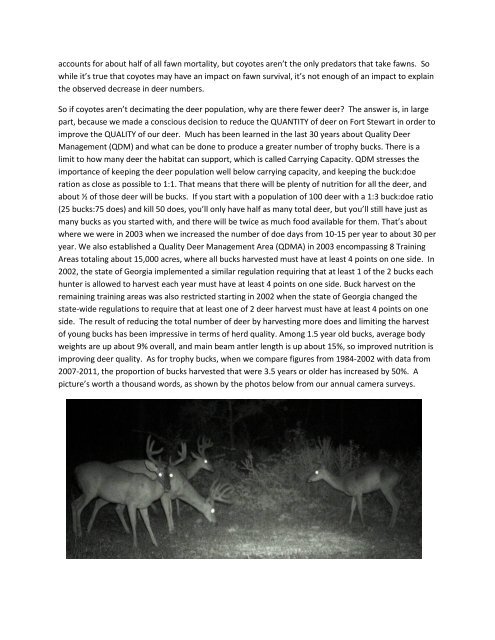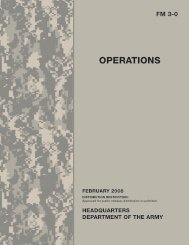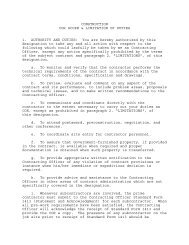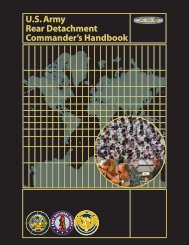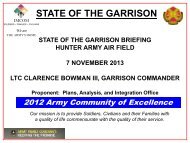Deer Article - Fort Stewart
Deer Article - Fort Stewart
Deer Article - Fort Stewart
You also want an ePaper? Increase the reach of your titles
YUMPU automatically turns print PDFs into web optimized ePapers that Google loves.
accounts for about half of all fawn mortality, but coyotes aren’t the only predators that take fawns. So<br />
while it’s true that coyotes may have an impact on fawn survival, it’s not enough of an impact to explain<br />
the observed decrease in deer numbers.<br />
So if coyotes aren’t decimating the deer population, why are there fewer deer? The answer is, in large<br />
part, because we made a conscious decision to reduce the QUANTITY of deer on <strong>Fort</strong> <strong>Stewart</strong> in order to<br />
improve the QUALITY of our deer. Much has been learned in the last 30 years about Quality <strong>Deer</strong><br />
Management (QDM) and what can be done to produce a greater number of trophy bucks. There is a<br />
limit to how many deer the habitat can support, which is called Carrying Capacity. QDM stresses the<br />
importance of keeping the deer population well below carrying capacity, and keeping the buck:doe<br />
ration as close as possible to 1:1. That means that there will be plenty of nutrition for all the deer, and<br />
about ½ of those deer will be bucks. If you start with a population of 100 deer with a 1:3 buck:doe ratio<br />
(25 bucks:75 does) and kill 50 does, you’ll only have half as many total deer, but you’ll still have just as<br />
many bucks as you started with, and there will be twice as much food available for them. That’s about<br />
where we were in 2003 when we increased the number of doe days from 10-15 per year to about 30 per<br />
year. We also established a Quality <strong>Deer</strong> Management Area (QDMA) in 2003 encompassing 8 Training<br />
Areas totaling about 15,000 acres, where all bucks harvested must have at least 4 points on one side. In<br />
2002, the state of Georgia implemented a similar regulation requiring that at least 1 of the 2 bucks each<br />
hunter is allowed to harvest each year must have at least 4 points on one side. Buck harvest on the<br />
remaining training areas was also restricted starting in 2002 when the state of Georgia changed the<br />
state-wide regulations to require that at least one of 2 deer harvest must have at least 4 points on one<br />
side. The result of reducing the total number of deer by harvesting more does and limiting the harvest<br />
of young bucks has been impressive in terms of herd quality. Among 1.5 year old bucks, average body<br />
weights are up about 9% overall, and main beam antler length is up about 15%, so improved nutrition is<br />
improving deer quality. As for trophy bucks, when we compare figures from 1984-2002 with data from<br />
2007-2011, the proportion of bucks harvested that were 3.5 years or older has increased by 50%. A<br />
picture’s worth a thousand words, as shown by the photos below from our annual camera surveys.


